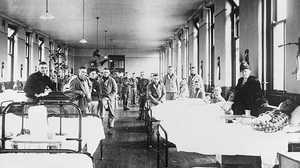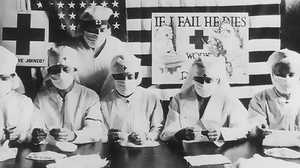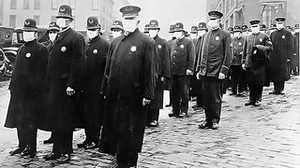The 1918 Influenza Pandemic and COVID-19
Much has changed since the influenza pandemic of 1918, yet our responses to COVID-19 must still rely on many of the century-old lessons.

Pandemic. The word originates from the Greek word pandēmos – meaning from ‘all’ (pan) ‘people’ (dēmos). Today, the word conjures many frightening images but holds similar meaning – a geographically widespread or global malady, generally with regard to infectious disease outbreaks. Indeed, for centuries, novel diseases and pathogens have emerged to produce pandemics in human populations, causing widespread illness and death, as well as economic, social and political disruptions.
The ancient Greeks believed diseases to be of a spiritual origin – a punishment from the gods for wrongdoings. In the 5th century BCE, an outbreak characterized by sore throat, aches and respiratory distress was noted by Hippocrates and named "The Cough of Perinthus." In doing so, Hippocrates may have provided the first documented experience of perhaps the most notorious pandemic pathogen: influenza. Although it is unlikely that the Cough of Perinthus was the first influenza outbreak in humans, it is the first chapter or at least the prologue to a dramatic history of significant human influenza outbreaks. Medical historians believe large scale influenza outbreaks occurred in 1510 and 1557 that may have been pandemics, but an outbreak in 1580 marks what is widely regarded as the first true influenza pandemic. This pandemic caused upwards of 8,000 deaths in Rome and devastated cities in Spain – literally decimating some by killing one out of every 10 residents. Since that time, we have documented two additional influenza pandemics in the 18th century, another two in the 19th century, three in the 20th century and one thus far in the 21st century.
Of these, an influenza pandemic occurring in 1918 is the most infamous. Fueled by the transport of soldiers in the final stages of World War I, the outbreak quickly spread around the world in three distinct waves, infecting up to one-third of the people on earth and killing an estimated 50 to 100 million people. Infections were complicated with high rates of bacterial pneumonia, and the pandemic was characterized by a uniquely high mortality rate in young adults between 20 and 40 years of age. By the time the pandemic ended in 1920, it was the worst acute infectious disease outbreak in modern history and the greatest mortality event in the world since the Black Death – a 14th-century pandemic caused by the plague.

The 1918 pandemic had profound impacts on life in the United States. In October of 1918, some 195,000 Americans were killed by the outbreak. By the time it ended, over 600,000 had lost their lives, and thousands of children were orphaned. So dire was the situation that many cities including Boston, Richmond, St. Louis and others mandated quarantines and social-distancing measures. In San Francisco and Seattle, laws were passed forcing people to wear masks covering their mouths and noses while in public. The public health commissioner in Chicago told police to arrest anyone seen sneezing without covering their face in public.
These horrors were exacerbated by a number of factors. Many physicians and nurses were enlisted in the armed forces to aid in the efforts to win the First World War, leaving a depleted healthcare workforce. The outbreak stoked nativist reactions and the stigmatization of certain ethnic groups – such as anti-Italian sentiments in Denver – which limited the effectiveness of efforts to curtail the outbreak. There were also restrictions on communication and the flow of information. President Woodrow Wilson created the Committee on Public Information when the United States entered World War I, and at Wilson’s urging, Congress passed the Sedition Act in 1918, which allowed for up to 20 years of imprisonment for criticizing the government or spreading information that could hamper the production of materials necessary for the war effort. To this end, the government printed materials urging people to report anyone “who spreads pessimistic stories...cries for peace, or belittles our effort to win the war” to the Justice Department. These greatly limited communication and delayed the public health response to the emerging health crisis [1]. For example, newspapers in Washington, D.C. did not begin reporting on the outbreak until the last week of August – months after it had begun.
Much has changed for the better since 1918. For one, after Dr. Richard Shope isolated the influenza virus in his laboratory in 1931, we now know that influenza is caused by a virus. We no longer need to exclusively rely on non-pharmaceutical interventions to respond to influenza pandemics because we have developed and refined our ability to create and produce safe and efficacious vaccines. Sir Alexander Fleming discovered penicillin in 1928, which opened the door for developing antibiotics that can help treat complications from influenza, such as pneumonia. There is now an entire field of diplomacy dedicated to health and responding to the global threats posed by infectious diseases. And we no longer name pandemics after geographic locations, people, animals or cultural references in efforts to avoid stigmatization.
However, there have also been changes since 1918 that complicate the responses to pandemics. A growing body of evidence suggests pandemics may occur more frequently due to changes in land use, exploitation of the natural environment and demographic trends like urbanization—all of which increase the risk of infectious disease outbreaks. Today’s society is also undoubtedly more globalized than that of 1918. The World Health Organization estimates that our world is so interconnected, a pathogen could conceivably spread around the world in 36 hours. Simulations suggest that if a highly contagious and lethal pandemic similar to the 1918 influenza were to occur today, approximately 33 million people could die in 6 months.
Presently, we find ourselves in the midst of another pandemic. In December of 2019, a novel virus emerged in China and quickly spread throughout the country and the world, causing a disease called COVID-19, which stands for Coronavirus Disease 2019. Similar to the 1918 influenza, COVID-19 is a respiratory disease and pneumonia can be a complication. It has emerged in a time characterized by rising sentiments of nationalism and isolationism, and one in which the role of the media is in the spotlight. The spread of the disease has been fueled by the transportation of people around the world. And while we currently do not know exactly how contagious or deadly COVID-19 is, because we do not yet know the true number of persons infected, estimates based on available data suggest that it has the potential to rival the 1918 influenza.

In the absence of pharmaceutical treatments and therapies for COVID-19, the response to the virus has relied heavily on non-pharmaceutical interventions and supportive treatment, much like the response to the 1918 influenza. Similarly, the response to COVID-19 has also witnessed the implementation of dramatic social distancing measures in cities, the passing of new policies designed to curtail the spread of disease and the stigmatization of people and culture that hinder the public health response.
The 1918 influenza pandemic was a pandemic in every sense of the word – global and affecting all people, from poor factory workers to world leaders like President Wilson. However, for all of the horrors that the 1918 influenza pandemic brought with it, the outbreak eventually came to an end and brought opportunities to learn and prepare for future pandemics. While our current situation is frightening, COVID-19 can be controlled through public health interventions, much as the influenza pandemic was eventually contained. The century-old lessons are clear: we must act swiftly, intentionally and implement multiple interventions simultaneously to curb the spread of disease.

Matthew Boyce (@mattrbo) is a Senior Research Associate at the Center for Global Health Science & Security at Georgetown University. His research is focused on global health security, sustainable capacity development, and public health preparedness—especially at the local and sub-national levels.

Dr. Rebecca Katz (@RebeccaKatz5) is a Professor and Director of the Center for Global Health Science and Security at Georgetown University Medical Center. She teaches courses on global health diplomacy, global health security, and emerging infectious diseases in the School of Foreign Service. Since 2007, much of her work has been on the domestic and global implementation of the International Health Regulations as well as global governance of public health emergencies.
[1] These restrictions also contribute to why 1918 influenza pandemic is commonly called the ‘Spanish Influenza.’ Spain was neutral in the First World War and did not censor its press. Thus, it was one of the only countries reporting on the pandemic at the time and as a result, thought to be where the outbreak began in 1918 despite the fact that modern evidence suggests the outbreak likely began at a U.S. Army camp in Kansas and had already been circulating in the United States of America for months.
Sources
- Georgios PappasabIsmene, J.KiriazeacMatthew, E.Falagas,Insights into infectious disease in the era of Hippocrates (ScienceDirect)
- Patrick R. Saunders-Hastings and Daniel Krewski,Reviewing the History of Pandemic Influenza: Understanding Patterns of Emergence and Transmission(Pathogens)
- C.W. Potter,A history of influenza (Journal of Applied Microbiology)
- Andrew Milsten, 1918 Influenza Pandemic: A United States Timeline (American College of Emergency Physicians)
- J. Alex Navarro, Alexandra Stern, Howard Markel (eds.), The American Influenza Epidemic of 1918: A Digital Encyclopedia
- Alan M. Kraut, Immigration, Ethnicity, and the Pandemic (Public Health Reports)
- David W. Seitz, World War I, Mass Death, and the Birth of the Modern US Soldier: A Rhetorical History
- WHO, World Health Organization Best Practices for the Naming of New Human Infectious Diseases
- Global Preparedness Monitoring Board, A World at Risk: Annual report on global preparedness for health emergencies
- Bill Gates, Shattuck Lecture
- Helen Branswell and Andrew Joseph, WHO declares the coronavirus outbreak a pandemic (STAT)
- Howard Markel, Harvey B. Lipman, J. Alexander Navarro, et al, Nonpharmaceutical Interventions Implemented by US Cities During the 1918-1919 Influenza Pandemic (JAMA)







